What Is The Difference Between WAP And WAF?
Discover the differences between WAF (Web Application Firewall) and WAP (Wireless Application Protocol) in cybersecurity by Understanding how WAF defends web applications from risks while WAP offers wireless access to web content to secure your online presence.
Exploring the Differences Between WAP and WAF in Cybersecurity
The WAP and WAF are commonly used for mobile communication and cybersecurity. Even though they may have similar sounds, they pertain to two different technologies with different uses. In this article, we will explain the distinctions between WAP (Wireless Application Protocol) and WAF (Web Application Firewall) by comprehending their distinctive features.
Wireless Application Protocol (WAP):
WAP is a communication protocol created especially for wireless devices. It makes it possible for mobile phones, tablets, and other wireless devices to connect to mobile networks and access web-based data and services. WAP provides a connection point for mobile devices and web servers, enabling browsing and content retrieval. It uses Wireless Markup Language (WML), a specialized markup language, to adapt information for smaller displays and constrained bandwidth. WAP gives mobile devices the ability to communicate with the internet and retrieve data in a format that is appropriate for them.
Web Application Firewall (WAF):
WAF protects web-based applications against a range of threats and vulnerabilities. serves as a security barrier by monitoring and filtering incoming requests between the web application and external traffic. Cross-site scripting (XSS), SQL injection, and distributed denial of service (DDoS) attacks are a few examples that have been detected and prevented by WAF when targeted at web-based applications. Protect websites and applications from malicious activity, unauthorized access attempts, and data breaches by utilizing rule sets, signature databases, behavior analysis, and anomaly detection.
Conclusion
Although WAP and WAF are separate technologies with unique goals and functions, they may sound identical. To successfully navigate the worlds of wireless communication and web application security, ensure flawless operation of mobile devices, and preserve significant web application attacks, it is essential to understand the distinctions between WAP and WAF.









